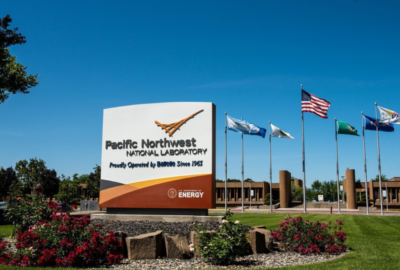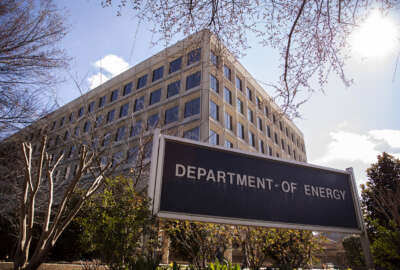Energy Department’s new place to explore offshore-wind technology
The Energy Department (DOE) has established a center of excellence for accelerating offshore wind energy.
The Energy Department (DOE) has established a center of excellence for accelerating offshore wind energy. DOE describes it as an academic and training hub helping the goal of 30 gigawatts of offshore wind energy by 2030. For more on the Federal Drive with Tom Temin, Federal News Network’s Eric White spoke to program analyst Laura Hastings and University of Massachusetts civil engineering professor Sanjay Arwade.
Interview Transcript:
Laura Hastings This project came together because in our federal government’s fiscal years ’22 and ’23, Congress directed us the Wind Energy Technologies Office to fund, and I’m quoting here, Congress. Centers of Excellence focused on offshore wind energy engineering, infrastructure, supply chain, transmission and other pertinent issues required to support offshore wind in the United States. So centers of excellence are hubs of subject matter expertise within a specific focus area that do research, provide insight and develop best practices and innovative solutions. So in March 2023, we put out a funding opportunity notice, and after a thorough process, announced the award earlier this month.
Eric White And Sanjay, why don’t you tell us about how you got involved in this and who made first contact or was this kind of your baby?
Sanjay Arwade To start, I’ll just say that the last year or a year and a half has been tremendously exciting for those of us working at academic institutions involved in offshore wind, particularly with respect to the many opportunities that came out of DOE, the various energy shots, and then the Center of Excellence solicitation as well. I think I can just say that we in academia, and especially here at UMass Amherst, had been waiting for an opportunity such as this to respond to DOE’s request for this kind of a university wide center.
Eric White Let’s get into those partnerships. How did you formulate all these partners that are going to go in on this with you?
Laura Hastings So part of our intention was to, partnerships are a big piece of this. In our funding announcement, we put forth seven pretty particular requirements for a successful application. We included sort of obvious ones, like education and research, as the center was to be university based. But we also required leadership and the partnership structure. We asked for partnerships with other higher ed institutions, research entities, community colleges, national labs, the private sector, NGOs, organized labor, utilities, tribes impacted and underserved communities, and state and local governments. And just energy transition requires an all hands on deck approach, and we wanted to ensure that the center had the capability to demonstrate their influence as a convener of relevant parties, and could also propel both their expertise and unique contributions to offshore wind, but also those of their partnering institutions.
Sanjay Arwade One of the things that’s going to be really fun for me about being involved in the center is that all of the participating institutions were already working together. Here at UMass Amherst, the Wind Energy Center has been operating as an education and research entity since the early 70s, and has ridden the ups and downs of the clean energy revolution. So it’s thrilling for UMass Amherst to be able to lead this center and build upon the more than 50 years of effort that’s already gone in from many faculty and students who came before me. I will take a moment to just name all of the institutional partners in Massachusetts. UMass Amherst is going to lead, and then two other campuses of the University of Massachusetts in Lowell and Dartmouth. Dartmouth is a South Coast, Massachusetts community. Northeastern University, which is in the city of Boston. Our second sort of center of gravity will be in Maryland, with Johns Hopkins University playing a significant role, and Morgan State University, an outstanding historically black university also located in the city of Baltimore. And then we have some specialized expertise joining us from Clemson University in South Carolina and the University of Puerto Rico, Mayaguez. On the national labs side, we’re really pleased, of course, to be working in [National Renewable Energy Laboratory (NREL)], but also to be participating with Argonne National Lab and Pacific Northwest National Lab as well. And as I mentioned, we have all been working together over the past 10 to 15 years on different research and education projects related to offshore wind, funded by DOE, by industry, by the various states, by the National Science Foundation. The other partnerships that I really want to call out and be appreciative of are particularly the partnership with the Commonwealth of Massachusetts through the tireless efforts of legislators of the Massachusetts Clean Energy Center and of the executive branch all the way up to, Governor Healy. Massachusetts is contributing $1 for dollar match to the Department of Energy funding, which is going to be crucial to us accomplishing our goals and really allowed us, I think, to propose an extremely ambitious, center. And then lastly, the state of Maryland also is contributing $1 million of cash to the project. That is also going to be really helpful in expanding the reach, both within Maryland but also nationally.
Eric White All right. And Laura, other than creating an arena for this center of excellence to take place, what else is the Department of Energy’s footprint on this project going to be? I imagine that some funds will be shifted that way, as they probably already have. But as far as the actual research itself, what role would DOE be playing in this?
Laura Hastings So our intention here is if you build it, they will come. However, some of our future role honestly is yet to be determined. We are just now entering the negotiation phase of the award. There’s the obvious funding piece through DOE, however, arrow, as Sanjay just mentioned, comes with a robust cost share piece as well. So while we are in the very, very early stages of the Center of Excellence, we are incredibly optimistic about its future impact on helping to close some of the workforce gaps that have been identified through our research and propelling just general U.S. offshore wind innovation as well.
Sanjay Arwade I think one of the things that we really liked about the way that DOE crafted the solicitation was the recognition that educational efforts going on at the bachelor’s, master’s and doctoral levels really are an integral part of workforce development for offshore wind. The Commonwealth of Massachusetts and the federal government and other states have been very supportive of technical training, upskilling and so on to try to ensure that we have in the U.S. the kind of workforce that’s needed to build, construct, maintain and operate offshore wind. And we’re very optimistic that arrow is going to help put the U.S. on an even footing, or maybe even a little bit ahead of northern Europe in terms of preparing the kind of engineers, environmental scientists, planners, economists and so on, that we think are going to be crucial to making offshore wind a success for the United States.
Eric White Got it. And let’s get into what this is all about, the actual use of offshore wind energy. Laura, can you kind of give me a sitrep on where the technology stands and what improvements have you seen in working with it? Just over the handful of years that it’s really been a force in the Green Energy Initiative.
Laura Hastings When discussing the impacts of efforts that will increase offshore wind in the United States, my answer is always yes. Which I know sort of begs the actual question, but every change in incremental ones will support the growth of the industry. This change, the center of excellence, is bigger than obviously one small incremental change. This is that education, research, community engagement, industry partnerships, energy justice and more. And so to the workforce piece, which is as my role, one of my workforce mantras is you can’t be it if you don’t see it. So the more folks that are engaged in offshore wind or the youth see this as a viable career opportunity. And not just viable, frankly, desirable, the industry is creating good jobs and jobs and a multitude of education and training levels. Yes, the industry needs PhDs. It also needs marketers and technicians and welders and mariners and teachers and trainers. And through our research, we’re finding there is a workforce gap. And if things don’t change, the workforce honestly won’t be prepared. So the more levers we can use to close that gap, the better off we are from an energy perspective, from an environmental perspective, from an economic perspective, and frankly, from a human perspective as well.
Eric White Gotcha. And so, Sanjay, there’s obviously a broad push towards using more of this kind of energy source. What level of energy can we actually expect from the technology if all was said and done and we were able to get major projects up and going?
Sanjay Arwade Yeah. I’ll just give a quick anecdote from here at UMass to tie back to what Laura was just saying. We had a speaker come from a company that does the design of support structures for offshore wind, a couple of weeks ago. And our normal kind of outside lectures attract a dozen students or something like that, and 3 or 4 faculty members. While we had a room of 50 people, 50 chairs, and it was standing room only. And at the same time, I teach a class on offshore structural design. And the enrollment in that class, over the three years that I’ve been teaching, it has more than doubled. So the the interest is there. And you’re absolutely right, Laura. People are starting to see the students are starting to see this as much more than just a viable career path, but a really exciting and tempting and rewarding one for a lot of different reasons. To get to your actual question, Eric. There’s no doubt in our number of reports largely out of NREL, the National Renewable Energy Lab, that document the incredible resource that we have, particular off the East coast of the United States, but really nationally. Including inland waterways, such as the Great Lakes, to meet energy needs in a clean and renewable fashion. And particularly again on the East Coast, the happy coincidence that a lot of the demand is kind of co-located with the resource. It’s windy off the coast of places like Washington and New Jersey, New York and Maryland and Massachusetts and Connecticut. So that for the US is a really happy coincidence, I would say. And I think at the universities, the things that we do are conduct research that is maybe a little bit longer term, maybe a little bit more foundational than what industry is going to do on its own in the product development sphere, but always with the goal of supporting real world change. We’re engineering professors. What we do is we design and we build. And so that’s certainly our goal here with respect to offshore wind. And then on the educational side, again, to just meet the needs of students, and meet the desires of students. And as I said in those couple of anecdotes, there’s no doubt in my mind that across all of the arrow institutions, across affiliates that are already expressing interest in joining the coalition, that there’s going to be huge demand for that kind of education and training over the years of the center and past the initial term of the center.
Copyright © 2025 Federal News Network. All rights reserved. This website is not intended for users located within the European Economic Area.
Tom Temin is host of the Federal Drive and has been providing insight on federal technology and management issues for more than 30 years.
Follow @tteminWFED






